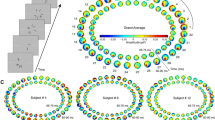Abstract
Scalp potentials elicited by pattern reversal, pattern onset, and flash stimulation have been studied in normal subjects by means of a 16-channel brain mapping system. In two groups of experiments the topography of the major positive component in each response was compared with 4° full- and lateral half-field stimuli and, for more detailed exploration of the pattern components by M-scaled stimuli selected to activate 1 cm2-patches of striate cortex and associated extrastriate re-projections. The 4° stimuli were found to elicit scalp distributions for the pattern reversal P100 and the pattern onset C1 consistent with striate and extrastriate visual cortical origins respectively. Data on the flash P2 component suggest that stimulation was not localized accurately; this may have been due to lateral spread of neural activity in the retina. Predictably, the M-scaled stimuli showed extensive inter- and intra-individual variations depending on stimulus type and location relative to fixation. The manner in which, in some subjects, the region of maximal activity on the map appears to migrate with change of stimulus position possibly reflects local retinotopic order in visual evoked potential generator areas. However, data are neither extensive nor detailed enough to be conclusive.
Similar content being viewed by others
References
Barret G, Blumhardt L, Halliday AM, Halliday E, Kriss A. A paradox in the lateralisation of the visual evoked response. Nature 1976; 261: 253–255.
Boynton RM. Stray light and the human electroretinogram. J Opt Soc Am 1953; 43: 442–449.
DeVoe RG, Ripps H, Vaughan HG Jr. Cortical responses to stimulation of the human fovea. Vision Res 1968; 8: 135–147.
Ditchburn RW, Foley Fisher IA. Assembled data on eye movements. Optica Acta 1967; 14: 113–118.
Drasdo N. The neural representation of visual space. Nature 1977; 266: 554–556.
Drasdo N. Cortical potentials evoked by pattern presentation in the foveal region. In: Barber C, ed. Evoked potentials. Lancaster: MTP Press, 1980; 167–174.
Drasdo N. Optical techniques for enhancing the specificity of visual evoked potentials. Doc Ophthalmol Proc Ser 1982; 31: 327–336.
Drasdo N. Electrophysiology of the human visual system. Ophthalmol Phys Opt 1983; 3: 321–329.
Drasdo N. The effect of perimetric stimulation on evoked potential distribution - a theoretical model. Ophthalmol Physiol Opt (in press).
Halliday AM. The visual evoked potential in healthy subjects. In: Halliday AM, ed. Evoked potentials in clinical testing. Edinburgh: Churchill Livingstone, 1982; 71–120.
Halliday AM, Michael WF. Changes in pattern-evoked responses in man associated with the vertical and horizontal meridians of the visual field. J Physiol 1970; 208: 499–513.
Harding GFA. The visual evoked response. Adv Ophthalmol 1974; 28: 2–28.
Harding GFA, Smith GF, Smith PA. The effect of various stimulation parameters on the lateralisation of the VEP. In: Barber C, ed. Evoked potentials. Lancaster: MTP Press, 1980; 213–218.
Holder GE. Abnormalities of the pattern visual evoked potential in patients with homonymous visual field defects. In; Barber C, ed. Evoked potentials. Lancaster: MTP Press, 1980; 285–298.
Jeffreys DA, Axford JG. Source locations of pattern-specific components of human visual evoked potentials. 1. Component of striate cortical origin. Exp Brain Res 1972; 16: 1–21.
Lesevre N, Joseph JP. Modifications of the pattern-evoked potential (PEP) in relation to the stimulated part of the visual field. Electroencephalogr Clin Neurophysiol 1979; 47: 183–201.
Robson JG. Neurophysiology of retinal ganglion cells and optic nerve. In: Hess RF, Plant GT, eds. Optic neuritis. Cambridge: Cambridge University Press, 1986; 19–41.
Stone J, Johnston E. The topography of primate retina; A study of the human, bushbaby and New- and Old-world monkeys. J Comp Neurol 1981; 196: 205–223.
Vos JJ, Walraven J, van Meeteren A. Light profiles of the foveal image of a point source. Vision Res 1976; 16: 215–219.
Author information
Authors and Affiliations
Rights and permissions
About this article
Cite this article
Edwards, L., Drasdo, N. Scalp distribution of visual evoked potentials to foveal pattern and luminance stimuli. Doc Ophthalmol 66, 301–311 (1987). https://doi.org/10.1007/BF00213658
Issue Date:
DOI: https://doi.org/10.1007/BF00213658




